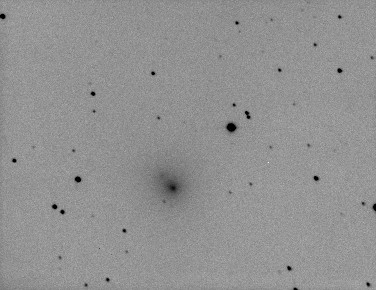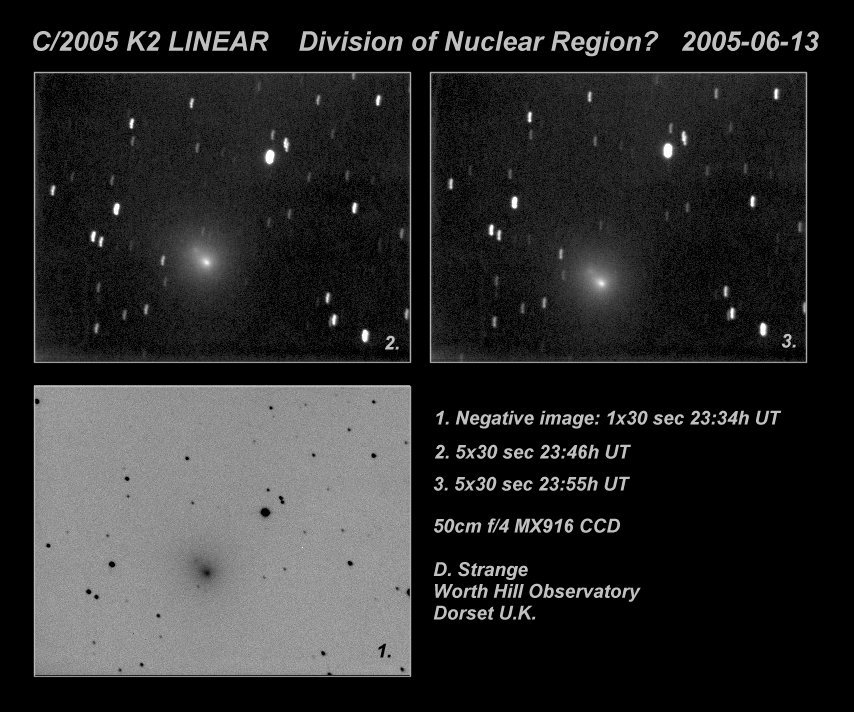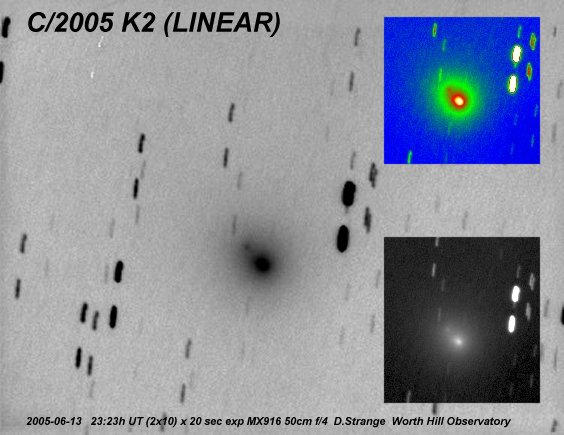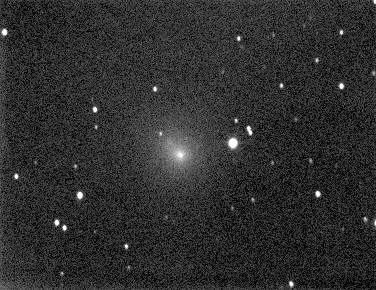C/2005 K2 (LINEAR)
Discovery of the Splitting of Comet 2005 K2 (LINEAR)
The night of June 13th beckoned clear and still with little wind, but
there was a crescent moon in the sky, fortunately not yet too bright to
interfere with comet observations.At this time of year it does not
really get dark until midnight so it was fairly late when I ventured
out to the observatory. I had in mind to view and image Comet 9P Tempel
the target of the Deep Impact Mission on July 4th and also a newly
discovered Comet 2005 K2 (LINEAR) which had been picked up three weeks
earlier by the LINEAR telescope from New Mexico. Comet LINEAR was my
first target as I had not yet imaged it and recent reports showed that
it was brightening very rapidly. It was 16th mag at discovery but had
undergone a significant rapid increase in brightness and now was an
easy target at 10th mag. With the help of Jon Shanklin’s comet
ephemeris for 2005 K2 I located its position and realised it lay at the
front feet of the Great Bear about 15 degrees above the north western
horizon so wasn’t ideally placed.
My telescope is old technology and far removed from anything
approaching a goto facility, so with the help of the finder scope
I identified some sixth mag field stars which lay close to the comet.
As luck would have it when I looked into the eyepiece there centrally
positioned was a faint misty patch. It looked deceptively round like a
comet but I was highly suspicious that I should have happened on the
comet so easily, and it seemed more likely to be a galaxy.
 C/2005 K2 (LINEAR) - 30 sec single exposure.
C/2005 K2 (LINEAR) - 30 sec single exposure.
However, I decided to grab a few images anyway which would help in its
identification, and the first image was caught at 2306h UT. A 30 sec
exposure revealed a circular object but there appeared to be an
elongation and a dimmer smaller patch to the north east and
my first impressions was that the object looked like a pair of close
interacting galaxies.
By the time I had centred the object for imaging its cometary motion
was obvious as it was moving rapidly to the south. At this stage I
realised that the secondary condensation was following the motion of
the comet, and had not parted from it. It is quite common to find stars
embedded in the coma of comets at times, but these appearances are
short lived as a comet motion will soon make it pass over
background stars which are bright enough to shine through.
I took two series of 10x20 sec exposures, and having done some rough
and ready image processing and blinking the images, it was now fully
apparent that what I was looking at was indeed a secondary condensation
which must have separated from its nucleus.
I continued imaging 5x30 sec exposures as these seemed to show the
secondary component more clearly. As I had not heard of any reports of
this comet breaking up I thought it worthwhile to report this
observation to Jon Shanklin and TA observers group and went back to
process these images and upload them. I also posted a message on the
Yahoo Groups Comets-m1 mailing list, and then retired late to bed at
4.00 am as dawn was breaking.

There were indeed other reports of this observation the next day, with
further images from Michael Jager & Gerald Rhemann and Giovanni
Sostero & Ernesto Guido. Jon Shanklin e-mailed that evening
to say that it was still not clear whether it was an outburst but it
was brightening at a rate of 40 log r (whatever that means!), he also
congratulated me for getting a mention in IAU Circular 8543. It may not
have been a great discovery but it was significant in a way, and at
least gave me some excitement for a few hours. It was reminiscent of
observations and images I took of Comet 1999 S4 (LINEAR). On that
occasion the nucleus took on a highly elongated appearance. This was
very shortlived as the comet broke up the next day. Keep looking up it
could be you next time who happens upon some otherwise unseen event
going on out there!

Here is an animation of my images of C/2005 F2 taken on June 13th 2005.
More news here.

 C/2005 K2 (LINEAR) - 30 sec single exposure.
C/2005 K2 (LINEAR) - 30 sec single exposure.

